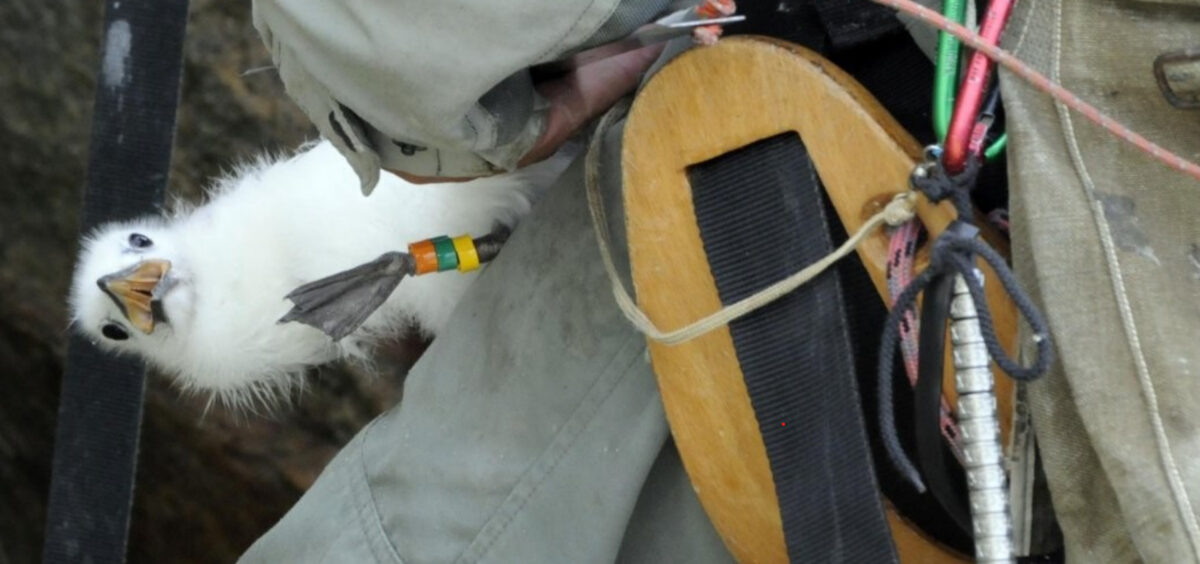Biased sex ratio in a Kittiwake population : Is being a female more lethal ?

Monitoring Kittiwakes populations through Capture – Mark – Recapture
Monitoring populations is important to predict their reactions to changes such as global warming and consequently to develop better protection measures. Monitoring is even more important to sensitive populations, like Black legged Kittiwake, a small seagull of the Larideae family and thus a long lived seabird, the most threatened group of birds. CMR (Capture – Mark – Recapture) is one of the most efficient monitoring method of a wild population. As it indeed allows minimal disturbances, CMR has been applied since the seventies on a population of R. tridactyla from Brittany (France).
Individuals are captured young, as hatchlings, and marked by six leg-rings. The rings sum is a unique combination allowing to identify an individual at sight, without recapturing it. A monitoring database is therefore built by reobserving marked individuals at their resights. Its statistical analysis allows to determinate the demographical state of the population.

Something doesn’t feel right about the Kittiwake population of the Cap Sizun
The last monitoring decade of this Kittiwake population on its breeding ground, the Cap Sizun (Finistère, France), gave observers the feeling that more young marked males than females were present (i.e., returning to the colony) during spring. Males being more abundant than females (expressed by a biased sex ratio in favor of males) would however go against stable population hypothesis. Indeed, stable populations like Rissa tridactyla are supposed to have an Adult Sex Ratio of 1 (ASR; the number of males over the number of females).
Nevertheless, such observations could be biased by the process of sex attribution. Kittiwake’s sex attribution cannot be based on sexual dimorphism since they do not display one. It is therefore based on their behavior. Besides, younglings need to both survive and be resight at maturity to be sexed. Thus, kittiwakes’ first five years of life time period constantly displays a high number of “unknown sex individuals”, making it hard to compute.
How to estimate an actual sex ratio then ?
To better understand Rissa tridactyla demography and to determinate if young males are indeed more abundant than young females, three hypotheses of factors possibly influencing the apparent sex ratio are tested in silico.
- Observers manage to sex males earlier than females, increasing their apparent numbers in younger age-class
- Males return to breeding ground and reproduce younger than females
- The male survival probability is higher than females
Each hypotheses are tested by exploring the data set with two different approaches. The first approach consists in comparing the abundance of males, females and of unknown sex individuals with a particular attention to pre-breeders, to compute the sex ratio. The second approach consists in finding for each individual how old they were when they were sexed.
In parallel, life history traits – parameters inluencing demography – such as survival probability are estimated using CMR models built in a bayesian framework, a type of statistics which takes into account prior distributions.
And the winning hypothesis is…
All hypotheses appeared to be supported by the two approaches and the CMR models. Hence, the pre-breeder sex ratio did not appear to be biased in favor of males, except concerning individuals aged from 2 to 3 years old. Nevertheless, the CMR models revealed that in the pre-breeder group, males displayed a higher survival probability than females. As these models do not discriminate death and emmigration, it could be because females are more likely to leave the colony since they are the emmigrant sex in this species.
The absence of bias in the sex ratio could result from males recruiting (i.e., breeding for the first time) younger than females. As a consequence, female wait longer to recruit, which increases their apparent number in the pre-breeder part of the population.
What does this teach us ?
Hence, the concomitant use of two distinct statistical approaches allowed to highlight complementary population characteristics and thus, led to a better understanding of Kittiwakes demography.
It is indeed now possible to conclude that in this Kittiwake population it is better to be born male than female unless you are a traveller (or suicidal).
 Attention, vous utilisez un navigateur peu sûr !
Attention, vous utilisez un navigateur peu sûr !